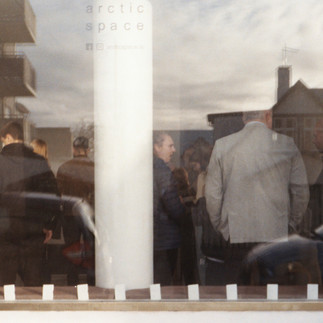Bata(ferli) · A healing city
- Már Másson Maack
- Mar 31
- 2 min read
Updated: Apr 29
02.04.25 - 31.05.25

sýnendur · exhibitors: Blanca L. Castaneda Bjarnarson, Emilý Klemensdóttir og Kristín Guðmundsdóttir
tímabil · period: 02.04.25 - 31.05.25
Hvernig getum við endurhugsað sár borgarinnar á manneskjulegan máta og komið að ferlinu með nánd og þekkingu? Bata(ferli) gerir tilraun til að svara þessum spurningum og hvetja sýningagesti til að enduruppgötva umhverfi sitt.
Sýningin er sprottin upp úr hugleiðingum um textílaðferðafræðina 'boro' sem að einkennist af bótum sem eru saumaðar saman. Sýnendurnir Blanca, Emilý og Kristín eru nýútskrifaðar úr BA-námi í arkitektúr og vildu varpa fram hugmyndum um hvernig væri hægt að yfirfæra þessa þekkingu á víðtækari máta.
Er möguleiki á að sauma saman sár borgarinnar? Líkt og mannslíkaminn, sýnir byggingin þolgæði – hún fær áverka og sárin hennar verða að einskonar fleyg úr fortíðinni. Í þessu samhengi má líta á sýninguna sem klíníska aðgerð sem skoðar þessi „sár“ og varpar ljósi á hljóðláta seiglu byggðarinnar.
Í nútímasamfélagi hefur viðhorf til líftíma bygginga gjörbreyst. Í stað þess að hlúa að þeim og viðhalda, er þeim einfaldlega skipt út um leið og fyrsta sprungan birtist. Þetta er bæði fjárhagslega hagkvæmara og mun hraðvirkara. Byggingarefnin eru jarðsett og ummerki þeirra hverfa undan uppbyggingu. Með því að hlúa að sárum byggingakroppa vonast sýnendurnir að fanga áþreifanlega vitnisburð um gang tímans, veðrun og mannlíf. Náum við þannig að varðveita minningabrot byggingarinnar áður en kropparnir verða þurrkaðir burt úr borgarmyndinni?
· English ·
How can we rethink the wounds of the city in a humane way, approaching the process with closeness and knowledge? A Healing City attempts to answer these questions and encourages visitors to rediscover their surroundings.
The exhibition grew out of reflections on the textile methodology known as boro, characterised by patches sewn together. The exhibitors, Blanca, Emilý, and Kristín, are recent graduates with a BA in architecture and wanted to explore how this knowledge could be applied in a broader context.
Is it possible to stitch together the wounds of the city? Like the human body, a building shows resilience – it sustains injuries, and its wounds become a kind of wedge from the past. In this sense, the exhibition can be seen as a clinical operation, examining these "wounds" and shedding light on the quiet resilience of the urban fabric.
In modern society, attitudes towards the lifespan of buildings have fundamentally changed. Instead of tending to and maintaining them, buildings are simply replaced as soon as the first crack appears. This is both more financially viable and much faster. Building materials are buried, and their traces disappear beneath new developments. By tending to the wounds of architectural bodies, the exhibitors hope to capture tangible evidence of the passage of time, weathering, and human life. Can we thus manage to preserve fragments of a building’s memory before the bodies are wiped away from the cityscape?






















